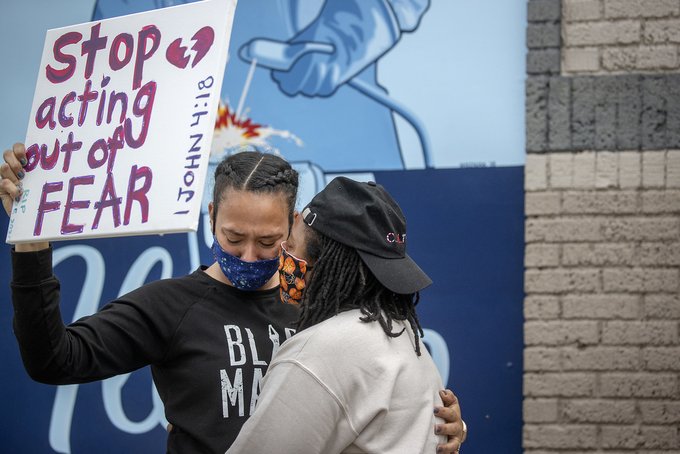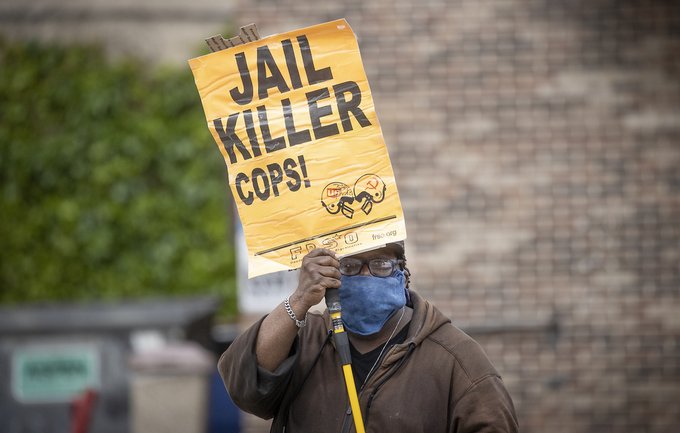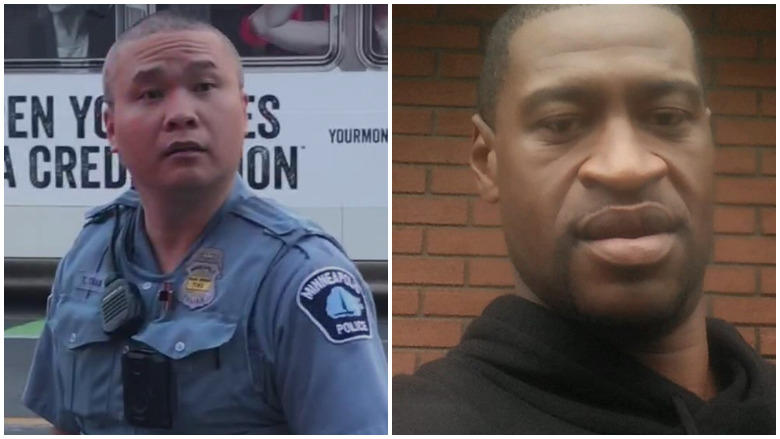
Facebook/Twitter Tou Thao (l) and George Floyd.
Tou Thao has been named as the Minneapolis, Minnesota, police officer who interacts with upset bystanders and stands watch in a viral video as another officer, Derek Chauvin, presses his knee on the neck of a man who pleads that he can’t breathe.
The man, George Floyd, later died, and the video, which went viral after being posted to Facebook, is sparking outrage and a federal investigation.
The City of Minneapolis has now named Thao, Chauvin, Thomas Lane, and J. Alexander Kueng as the officers present, according to the city. (Contrary to social media rumors, Thao is not the brother of Chauvin’s estranged wife, according to her attorney.)
AG Keith Ellison added a second-degree murder charge to the charges Derek Chauvin is facing on June 3. Lane, Thao and Kueng are now charged by Ellison with unintentional aiding and abetting second-degree murder as well as aiding and abetting second-degree manslaughter.
An independent autopsy conducted by a famed pathologist at the request of George Floyd’s family has found that “George Floyd’s death was due to asphyxia from sustained forceful pressure” by Minneapolis police officers, according to a news conference and release by the Floyd family attorneys.
“The knee to the neck and the knees to his back both contributed to him not being able to get breath,” said Floyd family attorney Ben Crump in the news conference. “And what those officers did, that we see on the video, is the cause of his death, not some underlying, unknown health condition. George Floyd was a healthy young man. We see in the video he was walking, breathing; he was alive. His cause of death medically was mechanical asphyxiation. The legal determination is homicide. That is it in a nutshell. The officers killed him based on a knee to his neck for almost nine minutes and two knees to his back compressing his lungs. The ambulance was his hearse.”
Officer Derek Chauvin has now been charged with third-degree murder and manslaughter in connection with George Floyd’s death. You can read more about that here. Asked about the other three officers at the scene of Floyd’s death, Hennepin County Attorney Mike Freeman said, “We felt it appropriate to focus on the most dangerous perpetrator. This case has moved with extraordinary speed.” He called Chauvin’s action “this criminal action.” As evidence, Freeman said he has had discussions with an expert and has a preliminary report from the medical examiner, body camera video, and witness statements. The other three officers are “under investigation. I anticipate charges,” he said.
The complaint says that Floyd’s autopsy revealed “no physical findings that support a diagnosis of traumatic asphyxia or strangulation. Mr. Floyd had underlying health conditions including coronary artery disease and hypertensive heart disease. The combined effects of Mr. Floyd being restrained by the police, his underlying health conditions and any potential intoxicants in his system likely contributed to his death.” Chauvin “had his knee on Mr. Floyd’s neck for 8 minutes and 46 seconds in total. Two minutes and 53 seconds of this was after Mr. Floyd was non-responsive. Police are trained that this type of restraint with a prone position is inherently dangerous,” the complaint says. It also says that Chauvin disregarded another officer, Thomas Lane, who asked, “should we roll him on his side?” Chauvin allegedly responded, “No, staying put where we got him,” the complaint says. (You can read an extensive interview that Heavy conducted with a use-of-force expert here. In that interview, he said that keeping Floyd in a prone position was the most dangerous aspect he saw in the viral video and said that law enforcement has known about those dangers for decades.)
According to CBS Minneapolis, in Minneapolis, “kneeling on a suspect’s neck is allowed under the department’s use-of-force policy for officers who have received training in how to compress a neck without applying direct pressure to the airway.” However, some police training experts told the station they believed the officer compressed Floyd’s neck for too long because he was under control and not fighting them.
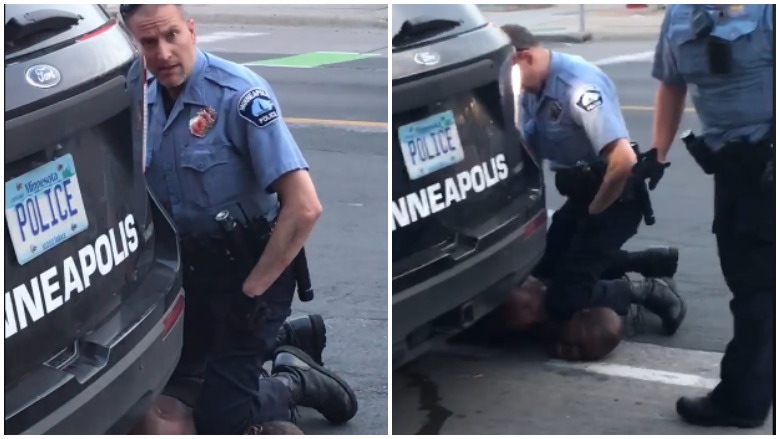
FacebookChauvin holding his knee on the neck of Floyd.
Floyd’s sister, Vanita Williams-Dabney, wrote on Facebook, “My bro was killed by Minneapolis police on Memorial Day …R I.P. bro we will get Justice for u ..gone2soon ..loveU4life.”
Minneapolis Mayor Jacob Frey tweeted that “four responding MPD officers involved in the death of George Floyd have been terminated. This is the right call.” He didn’t name them.
Floyd was originally from Houston, Texas. He was known by the nickname “Big Floyd,” his Facebook page says. The Star Tribune reported that the initial call came in for someone using a counterfeit bill at a store, Cup Foods, at 3759 Chicago Avenue. When police arrived, they believed Floyd matched the description and found him sitting on the hood of his car, according to the newspaper.
You can watch the video later in this article, but be forewarned: it’s very troubling.
Heavy reached out to Tom Kelly, the lawyer for Chauvin, and his office said Kelly is not commenting right now on the case and that reporters should direct their questions to the Minneapolis Police Department. It’s not clear whether Thao is represented by a lawyer.
A national expert on police use of force described the Minneapolis police officers’ actions in the viral video on George Floyd “appalling,” expressing concerns about officers keeping Floyd in a prone position for so long.
Seth Stoughton is an associate professor at the University of South Carolina School of law, a former Florida police officer, and co-author of a book called Evaluating Police Uses of Force. He studies policing and how it is regulated. He spoke to Heavy at length about the Floyd video and police restraint techniques to provide context.
“I honestly don’t see a whole lot that went right,” said Stoughton of what occurred in the citizen video. “They should have realized there was something wrong,” he said, adding that the amount of time Floyd was kept in the prone position was “completely inappropriate.”
As for the other three officers who aren’t Chauvin, he said prosecutors will have to show they were a “part of his cause of death. If they had used force on him, used hands on, that’s a little easier – if they actively contributed.” He said criminal liability will be tougher to prove in a case like Officer Thao’s where he was standing there and interceding with bystanders, according to the video.
Stoughton said the other officers could theoretically have criminal liability for failing to act. “A prosecutor might argue that Officer Thao caused or contributed to his (Floyd’s) death by not intervening,” he said.
Stoughton said the officers had a moral and professional duty to intervene but whether that falls under criminal statues will turn on a complex reading of Minnesota law. You can read more of Stoughton’s interview here.
Here’s what you need to know:
A Federal Investigation Was Launched Into Floyd’s Death After the Video Showed Chauvin Pressing His Knee on Floyd’s Neck as Thao Stood Guard
Federal authorities are now investigating the death.
“As additional information has been made available, it has been determined that the Federal Bureau of Investigations will be a part of this investigation,” Minneapolis police wrote in a news release. Floyd’s name was released by community leaders.
The police chief revealed that four officers involved in the incident were fired, saying in a May 26 news conference that “there are inherent dangers in the profession of policing, but the vast majority of the work we do does never require use of force.” He offered his “deepest condolences” to Floyd’s family members, saying he was up all night “reviewing the information that I have to make the decision that I am standing before you today with many of the community leaders behind me.”
He then referred to the four involved officers as “former employees,” saying, “I’ve made that decision this afternoon.” He said the death is still an ongoing criminal matter being investigated by agencies including the FBI.
“What occurred last night is certainly very tragic, and very sad,” said the police chief.
He said that public trust “must be the cornerstone” of how the Minneapolis Police Department will change its culture.
“The vast majority of the men and women who proudly put on this uniform each and every day understand the important role and relationship we must have with all of our community members,” said the chief.
At the news conference the mayor said, “I will say simply that I support your decision 100%. It is the right decision for our city. The right decision for our community. The right decision for our Minneapolis Police Department. We’ve stated our values, and we need to live by them.”
A 10-minute video of the incident was posted to Facebook by a bystander. It paints an extremely troubling scene of what happened to Floyd. In that video, Chauvin presses his knee on Floyd’s neck, while Thao stands nearby, constantly trying to keep upset bystanders at bay. His role appears to be to keep bystanders from pressing closer to Chauvin and Floyd. Thao isn’t seen touching Floyd at any point in the video.
“Please, I can’t breathe. Please man. Please,” Floyd says, his voice anguished.
The officer, now identified as Chauvin, has his knee on the man’s neck next to a squad car as Floyd continues saying he can’t breathe. Bystanders grow increasingly distressed in the video at what they are watching.
“Why you got him down, man. Let him breathe at least, man,” says one bystander to the officers.
Floyd repeats again, several times, “I can’t breathe.” He adds, “I can’t move . . . my stomach hurts. My neck hurts. Everything hurts. Please, please.”
“His nose is bleeding, c’mon now,” says a bystander. “You’ve got your knee on his neck,” says another bystander.
“How long you’ll gotta hold him down?” says a woman. “You can put him in a car,” says a man.
“That’s bullsh*t bro…you’re f*cking stopping his breathing,” says a bystander.
People challenge the officer to just put the man in a car. The bystanders call the officer a “bum” and claim he’s stopping Floyd’s breathing.
Partway through the video, Floyd stops talking, but Chauvin kept his knee on his neck.
“He’s not responsive right now,” challenges a bystander.
“Check his pulse,” demands a man.
The second officer, Thao, sometimes interacts with the bystanders, although it’s difficult to hear what he is saying. “Check his pulse. The man ain’t move yet, bro,” demands a bystander.
“He’s not f*cking moving. Get off of his f*cking neck,” the man yells. “Are you serious? Are you serious?”
“He’s black. They don’t care,” says a woman.
Paramedics eventually show up with a gurney after Floyd has gone silent for some time.
“The fact you guys aren’t checking his pulse and doing compression if he needs help?” says an upset woman.
“You just really killed that man, bro,” says a man to Chauvin, who appears unemotional and impassive throughout the video.
The Initial Police Press Release Claimed Floyd ‘Physically Resisted Officers’ but the Mayor & Others Have Expressed Outrage
The initial headline on the police press release stated, “Man Dies After Medical Incident During Police Interaction.” However, outrage is growing.
According to the Star Tribune, police spokesman John Elder said Floyd died at a nearby hospital a short time later. He “suffered a medical episode while struggling with officers,” Elder said a few hours after the incident occurred and said he appeared to be under the influence of either alcohol or another drug, the newspaper reported. However, Elder now says the chokehold was not a department-authorized technique, according to the newspaper, which quoted him as saying, “In my years as an officer, that would not be what I would ever consider a chokehold.”
Frey has been harshly critical of the officer’s actions, saying in a Tuesday press conference, “For five minutes, we watched a white officer press his knee into a black man’s neck. Five minutes. When you hear someone calling for help, you’re supposed to help. This officer failed in the most basic, human sense. What happened on Chicago and 38th last night is awful. It was traumatic. It serves as a reminder of how far we have to go.”
According to the police press release, “On Monday evening, shortly after 8:00 pm, officers from the Minneapolis Police Department responded to the 3700 block of Chicago Avenue South on a report of a forgery in progress. Officers were advised that the suspect was sitting on top of a blue car and appeared to be under the influence.”
At that point:
Two officers arrived and located the suspect, a male believed to be in his 40s, in his car. He was ordered to step from his car. After he got out, he physically resisted officers. Officers were able to get the suspect into handcuffs and noted he appeared to be suffering medical distress. Officers called for an ambulance. He was transported to Hennepin County Medical Center by ambulance where he died a short time later.
The release added, “At no time were weapons of any type used by anyone involved in this incident. The Minnesota Bureau of Criminal Apprehension has been called in to investigate this incident at the request of the Minneapolis Police Department. No officers were injured in the incident. Body worn cameras were on and activated during this incident.”
In a news conference after outrage erupted over the video and death, Minneapolis Police Chief Medaria Arradondo said he asked for the federal investigation because there was “additional information that I had received that quite frankly, from community sources, that just provided more context than I had preliminarily.”
A Series of Complaints Was Filed Against an Officer Tou Thao in Minneapolis & He Was Accused of Excessive Force in Another Incident
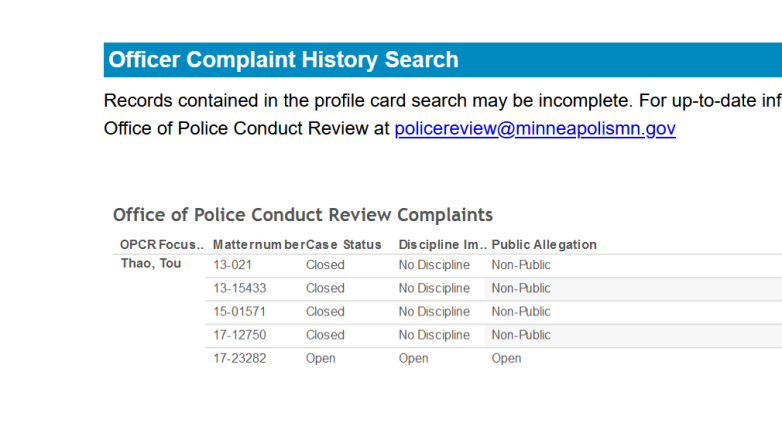
Tou Thao complaints.
City records show a settlement in an excessive force lawsuit involving Thao. “Approving the settlement of the lawsuit Lamar Ferguson v. Robert Thunder, Tou Thao, and the City of Minneapolis, (Court File No. 17-cv-01110), by payment of $25,000 to Lamar Ferguson and his attorneys, Leventhal PLLC, and authorizing the City Attorney’s Office to execute any documents necessary to effectuate the settlement,” they say.
According to the Minneapolis Star Tribune, Thao “started with the department as a community service officer. He went through the academy in 2009. He was laid off for two years and returned to the department in 2012.”
The Ferguson case involved Thao and Thunder, also a police officer. Ferguson claimed excessive force, saying he was walking with a pregnant woman when the two officers stopped and searched him without cause. According to the lawsuit, Thao “threw him to the ground and began punching him, while Thunder kicked him,” the Star Tribune reported.
Ferguson was taken to jail in his underwear and T-shirt after going to the hospital, according to the Star Tribune.
Thao said in a deposition that he punched Ferguson only when his hand slipped out of handcuffs, the newspaper reported.
“He tries to pull away,” Thao said in the deposition, according to the Star Tribune. “And he puts his hands on me and tries to give me a stiff arm in a way to try to get me off of him. After — at this point he’s actively resisting arrest. He — so I had no choice but to punch him. I punched him in the face. It causes him to pause a bit which gives Officer Thunder the time to come around and help.”
Multiple complaints come up against a Minneapolis Police Officer named Tou Thao in the police database but four are listed as “no discipline.” The fifth is listed as open. The details of the incidents were not clear.
Heavy has asked the police review board for the details. Heavy has also asked the Minneapolis police spokesman to verify that there isn’t another Tou Thao on the police force.
A 2014 appellate case mentions an Officer Tou Thao:
On August 8, 2012, a Minneapolis police dispatcher received a 911 call about a male harassing a female in a parking lot near Tenth Street and Portland Avenue. Minneapolis Police Officer Tou Thao responded to the call and spoke with the victim, I.A., who stated that her ex-boyfriend threatened her with a six-inch kitchen knife. I.A. stated that the ex-boyfriend wanted her to go somewhere with him, and, when she refused, he took a knife out of his pocket and threatened to kill her if she did not go with him. I.A. told Thao that the ex-boyfriend only threatened her and did not touch her. But on the domestic-violence form that Thao had I.A. complete, she reported that the ex-boyfriend pushed her, kicked her, and pulled her hair. Thao did not see any injuries on I.A. and did not ask about the discrepancies between her oral statements and the written form. Thao and his partner were unable to locate the suspect.
A suspect was later located. The court sided against the defendant, who challenged his conviction.
READ NEXT: Man’s Central Park Encounter With Central Park Dog Walker Goes Viral

